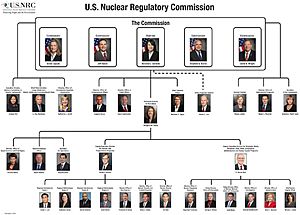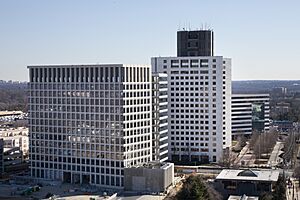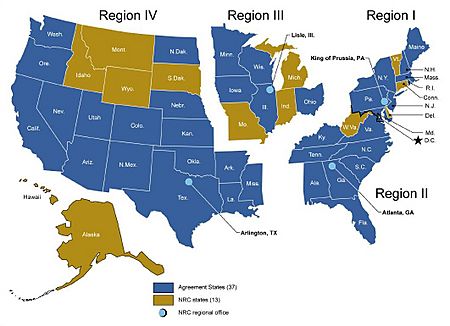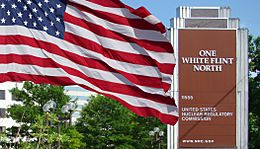Nuclear Regulatory Commission facts for kids
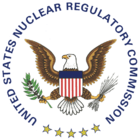 |
|
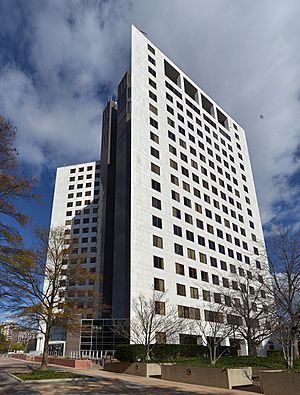 |
|
| Agency overview | |
|---|---|
| Formed | January 19, 1975 |
| Preceding agency | |
| Headquarters | North Bethesda, Maryland |
| Employees | 2,868 (2021) |
| Annual budget | $879 million (2021) |
| Agency executive |
|
The Nuclear Regulatory Commission (NRC) is an independent agency of the United States government tasked with protecting public health and safety related to nuclear energy. Established by the Energy Reorganization Act of 1974, the NRC began operations on January 19, 1975, as one of two successor agencies to the United States Atomic Energy Commission. Its functions include overseeing reactor safety and security, administering reactor licensing and renewal, licensing radioactive materials, radionuclide safety, and managing the storage, security, recycling, and disposal of spent fuel.
Contents
History
Prior to 1975 the Atomic Energy Commission was in charge of matters regarding radionuclides. The AEC was dissolved, because it was perceived as unduly favoring the industry it was charged with regulating. The NRC was formed as an independent commission to oversee nuclear energy matters, oversight of nuclear medicine, and nuclear safety and security.
The U.S. AEC became the Energy Research and Development Administration (ERDA) in 1975, responsible for development and oversight of nuclear weapons. Research and promotion of civil uses of radioactive materials, such as for nuclear non-destructive testing, nuclear medicine, and nuclear power, was split into the Office of Nuclear Energy, Science & Technology within ERDA by the same act. In 1977, ERDA became the United States Department of Energy (DOE). In 2000, the National Nuclear Security Administration was created as a subcomponent of DOE, responsible for nuclear weapons.
Following the Fukushima nuclear disaster in 2011, the NRC developed a guidance strategy known as "Diverse and Flexible Coping Strategies (FLEX)" which requires licensee nuclear power plants to account for beyond-design-basis external events (seismic, flooding, high-winds, etc.) that are most impactful to reactor safety through loss of power and loss of ultimate heat sink. FLEX Strategies have been implemented at all operating nuclear power plants in the United States.
The origins and development of NRC regulatory processes and policies are explained in five volumes of history published by the University of California Press. These are:
- Controlling the Atom: The Beginnings of Nuclear Regulation 1946–1962 (1984).
- Containing the Atom: Nuclear Regulation in a Changing Environment, 1963–1971 (1992).
- Permissible Dose: A History of Radiation Protection in the Twentieth Century (2000)
- Three Mile Island: A Nuclear Crisis in Historical Perspective (2004)
- The Road to Yucca Mountain: The Development of Radioactive Waste Policy in the United States (2009).
The NRC has produced a booklet, A Short History of Nuclear Regulation 1946–2009, which outlines key issues in NRC history. Thomas Wellock, a former academic, is the NRC historian. Before joining the NRC, Wellock wrote Critical Masses: Opposition to Nuclear Power in California, 1958–1978.
Mission and commissioners
The NRC's mission is to regulate the nation's civilian use of byproduct, source, and special nuclear materials to ensure adequate protection of public health and safety, to promote the common defense and security, and to protect the environment. The NRC's regulatory mission covers three main areas:
- Reactors – Commercial reactors for generating electric power and research and test reactors used for research, testing, and training
- Materials – Uses of nuclear materials in medical, industrial, and academic settings and facilities that produce nuclear fuel
- Waste – Transportation, storage, and disposal of nuclear materials and waste, and decommissioning of nuclear facilities from service.
The NRC is headed by five commissioners appointed by the president of the United States and confirmed by the United States Senate for five-year terms. One of them is designated by the president to be the chairman and official spokesperson of the commission.
The current chairman is Christopher T. Hanson. President Biden designated Hanson as chairman of the NRC effective January 20, 2021.
List of chairmen
| No. | Name (chair) | Photo | Term of office | Appointed by | |
|---|---|---|---|---|---|
| 1 | Bill Anders |  |
January 19, 1975 | April 20, 1976 | Gerald Ford |
| 2 | Marcus A. Rowden |  |
January 19, 1975 | January 15, 1977 | |
| 3 | Joseph M. Hendrie |  |
March 3, 1977 | December 7, 1979 | Jimmy Carter |
| 4 | John F. Ahearne |  |
December 7, 1979 | March 2, 1981 | |
| 5 | Nunzio J. Palladino |  |
July 1, 1981 | June 30, 1986 | Ronald Reagan |
| 6 | Lando W. Zech Jr. |  |
July 1, 1986 | June 3, 1989 | |
| 7 | Kenneth Monroe Carr |  |
July 1, 1989 | June 30, 1991 | George H.W Bush |
| 8 | Ivan Selin |  |
July 1, 1991 | June 30, 1995 | |
| 9 | Shirley Ann Jackson |  |
July 1, 1995 | June 30, 1999 | Bill Clinton |
| 10 | Richard Meserve |  |
October 29, 1999 | March 31, 2003 | |
| 11 | Nils J. Diaz |  |
April 1, 2003 | June 30, 2006 | George W. Bush |
| 12 | Dale E. Klein |  |
July 1, 2006 | May 13, 2009 | |
| 13 | Gregory Jaczko |  |
May 13, 2009 | July 9, 2012 | Barack Obama |
| 14 | Allison Macfarlane |  |
July 9, 2012 | December 31, 2014 | |
| 15 | Stephen G. Burns |  |
January 1, 2015 | January 23, 2017 | |
| 16 | Kristine Svinicki |  |
January 23, 2017 | January 20, 2021 | Donald Trump |
| 17 | Christopher T. Hanson |  |
January 20, 2021 | Incumbent | Joe Biden |
List of commissioners
| Portrait | Commissioner | Took office | Left office |
|---|---|---|---|
 |
Marcus A. Rowden | January 19, 1975 | April 20, 1977 |
 |
Edward A. Mason | January 19, 1975 | January 15, 1977 |
 |
Victor Gilinsky | January 19, 1975 | June 30, 1984 |
 |
Richard T. Kennedy | January 19, 1975 | June 30, 1980 |
 |
Joseph Hendrie | August 9, 1977 | June 30, 1981 |
 |
Peter A. Bradford | August 15, 1977 | March 12, 1982 |
 |
John F. Ahearne | July 31, 1978 | June 30, 1983 |
 |
Nunzio J. Palladiono | July 1, 1981 | June 30, 1986 |
 |
Thomas M. Roberts | August 3, 1981 | June 30, 1990 |
 |
James K. Asselstine | May 17, 1982 | June 30, 1987 |
 |
Frederick M. Bernthal | August 4, 1983 | June 30, 1988 |
 |
Lando W. Zech Jr. | July 3, 1984 | June 30, 1989 |
 |
Kenneth Monroe Carr | August 14, 1986 | June 30, 1991 |
 |
Kenneth C. Rogers | August 7, 1987 | June 30, 1997 |
 |
James R. Curtiss | October 20, 1988 | June 30, 1993 |
 |
Forrest J. Remick | December 1, 1989 | June 30, 1994 |
 |
Ivan Selin | July 1, 1991 | June 30, 1995 |
 |
E. Gail de Planque | December 16, 1991 | June 30, 1995 |
 |
Shirley Ann Jackson | May 2, 1995 | June 30, 1999 |
 |
Greta J. Dicus | February 15, 1996 | June 30, 2003 |
 |
Nils J. Diaz | August 23, 1996 | June 30, 2006 |
 |
Edward McGaffigan Jr. | August 28, 1996 | September 2, 2007 |
 |
Jeffrey S. Merrifield | October 23, 1998 | June 30, 2007 |
 |
Richard Meserve | October 29, 1999 | March 31, 2003 |
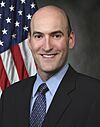 |
Gregory Jaczko | January 21, 2005 | July 9, 2012 |
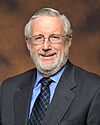 |
Peter B. Lyons | January 25, 2005 | June 30, 2009 |
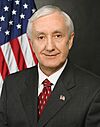 |
Dale E. Klein | July 1, 2006 | March 29, 2010 |
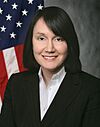 |
Kristine Svinicki | March 28, 2008 | January 20, 2021 |
 |
George Apostolakis | March 29, 2010 | June 30, 2014 |
 |
William D. Magwood IV | March 29, 2010 | August 31, 2014 |
 |
William C. Ostendorff | March 29, 2010 | June 30, 2016 |
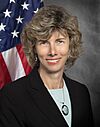 |
Allison Macfarlane | July 9, 2012 | December 31, 2014 |
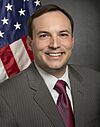 |
Jeff Baran | October 14, 2014 | June 30, 2023 |
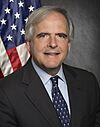 |
Stephen G. Burns | November 4, 2014 | April 30, 2019 |
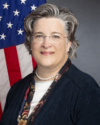 |
Annie Caputo | May 29, 2018 | June 30, 2021 |
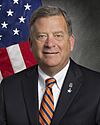 |
David A. Wright | May 30, 2018 | Present |
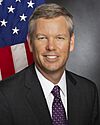 |
Christopher T. Hanson | June 8, 2020 | Present |
 |
Annie Caputo | August 9, 2022 | Present |
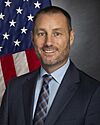 |
Bradley Crowell | August 26, 2022 | Present |
Current commissioners
| Name | Party | Took office | Term expires |
|---|---|---|---|
| Christopher T. Hanson (Chair) | Democratic | June 8, 2020 | June 30, 2024 |
| David A. Wright | Republican | May 30, 2018 | June 30, 2025 |
| Annie Caputo | Republican | August 9, 2022 | June 30, 2026 |
| Bradley Crowell | Democratic | August 26, 2022 | June 30, 2027 |
| Vacant |
Organization
The NRC consists of the commission on the one hand and offices of the executive director for Operations on the other. The commission is divided into two committees (Advisory Committee on Reactor Safeguards and Advisory Committee on the Medical Uses of Isotopes) and one Board, the Atomic Safety and Licensing Board Panel, as well as eight commission staff offices (Office of Commission Appellate Adjudication, Office of Congressional Affairs, Office of the General Counsel, Office of International Programs, Office of Public Affairs, Office of the Secretary, Office of the Chief Financial Officer, Office of the Executive Director for Operations).
Christopher T. Hanson is the chairman of the NRC. There are 14 Executive Director for Operations offices: Office of Nuclear Material Safety and Safeguards, Office of Nuclear Reactor Regulation, Office of Nuclear Regulatory Research, Office of Enforcement, which investigates reports by nuclear power whistleblowers, specifically the Allegations Program, Office of Investigations, Office of Nuclear Security and Incident Response, Region I, Region II, Region III, Region IV, Office of the Chief Information Officer, Office of Administration, Office of the Chief Human Capital Officer, and Office of Small Business and Civil Rights.
Of these operations offices, NRC's major program components are the first two offices mentioned above.
NRC's proposed FY 2015 budget is $1,059.5 million, with 3,895.9 full-time equivalents (FTE), 90 percent of which is recovered by fees. This is an increase of $3.6 million, including 65.1 FTE, compared to FY 2014.
NRC headquarters offices are located in unincorporated North Bethesda, Maryland (although the mailing address for two of the three main buildings in the complex list the city as Rockville, MD), and there are four regional offices.
Regions
The NRC territory is broken down into four geographical regions; until the late 1990s, there was a Region V office in Walnut Creek, California which was absorbed into Region IV, and Region V was dissolved.
- Region I, located in King of Prussia, Pennsylvania, oversees the northeastern states.
- Region II, located in Atlanta, Georgia, oversees most of the southeastern states.
- Region III, located in Lisle, Illinois, oversees the Midwest.
- Region IV, located in Arlington, Texas, oversees the western and south central states.
In these four regions NRC oversees the operation of US nuclear reactors, namely 94 power-producing reactors, and 31 non-power-producing, or research and test reactors. Oversight is done on several levels. For example:
- Each power-producing reactor site has resident inspectors, who monitor day-to-day operations.
- Numerous special inspection teams, with many different specialties, routinely conduct inspections at each site.
Recordkeeping system
NRC has a library, which also contains online document collections. In 1984 it started an electronic repository called ADAMS, the Agencywide Documents Access and Management System. for its public inspection reports, correspondence, and other technical documents written by NRC staff, contractors, and licensees. It has been upgraded in October 2010 and is now webbased. Of documents from 1980 to 1999 only some have abstracts and/or full text, most are citations. Documents from before 1980 are available in paper or microfiche formats. Copies of these older documents or classified documents can be applied for with a FOIA request.
Training and accreditation
NRC conducts audits and training inspections, observes the National Nuclear Accrediting Board meetings, and nominates some members.
The 1980 Kemeny Commission's report after the Three Mile Island accident recommended that the nuclear energy industry "set and police its own standards of excellence". The nuclear industry founded the Institute of Nuclear Power Operations (INPO) within 9 months to establish personnel training and qualification. The industry through INPO created the 'National Academy for Nuclear Training Program' either as early as 1980 or in September 1985 per the International Atomic Energy Agency. INPO refers to NANT as "our National Academy for Nuclear Training" on its website. NANT integrates and standardizes the training programs of INPO and US nuclear energy companies, offers training scholarships and interacts with the 'National Nuclear Accrediting Board'. This Board is closely related to the National Academy for Nuclear Training, not a government body, and referred to as independent by INPO, the Nuclear Energy Institute, and nuclear utilities. but not by the NRC, all of whom are represented on the board.
The 1982 Nuclear Waste Policy Act directed NRC in Section 306 to issue regulations or "other appropriate regulatory guidance" on training of nuclear plant personnel. Since the nuclear industry already had developed training and accreditation, NRC issued a policy statement in 1985, endorsing the INPO program. NRC has a memorandum of agreement with INPO and "monitors INPO activities by observing accreditation team visits and the monthly NNAB meetings".
In 1993, NRC endorsed the industry's approach to training that had been used for nearly a decade through its 'Training Rule'. In February 1994, NRC passed the 'Operator Requalification Rule' 59 FR 5938, Feb. 9, 1994, allowing each nuclear power plant company to conduct the operator licensing renewal examination every six years, eliminating the requirement of NRC-administered written requalification examination.
In 1999, NRC issued a final rule on operator initial licensing examination, that allows companies to prepare, proctor, and grade their own operator initial licensing examinations. Facilities can "upon written request" continue to have the examinations prepared and administered by NRC staff, but if a company volunteers to prepare the examination, NRC continues to approve and administer it.
Since 2000 meetings between NRC and applicants or licensees have been open to the public.
Prospective nuclear units
Between 2007 and 2009, 13 companies applied to the Nuclear Regulatory Commission for construction and operating licenses to build 25 new nuclear power reactors in the United States. However, the case for widespread nuclear plant construction was eroded due to abundant natural gas supplies. Many license applications for proposed new reactors were suspended or cancelled. These will not be the cheapest energy options available, therefore not an attractive investment. In 2013, four reactors were permanently closed: San Onofre 2 and 3 in California, Crystal River 3 in Florida, and Kewaunee in Wisconsin. Vermont Yankee, in Vernon, was shut down on December 29, 2014. New York state eventually closed Indian Point Energy Center, in Buchanan, 30 miles from New York City, on April 30, 2021.
In 2019 the NRC approved a second 20-year license extension for Turkey Point units 3 and 4, the first time NRC had extended licenses to 80 years total lifetime. Similar extensions for about 20 reactors are planned or intended, with more expected in the future. This will reduce demand for replacement new builds.
See also
 In Spanish: Comisión Reguladora Nuclear de Estados Unidos para niños
In Spanish: Comisión Reguladora Nuclear de Estados Unidos para niños
- International Atomic Energy Agency
- International Nuclear Regulators' Association
- List of canceled nuclear plants in the United States
- Nuclear power in the United States
- Nuclear renaissance in the United States
- Nuclear safety in the United States
- Title 10 of the Code of Federal Regulations
- Atomic Safety and Licensing Board



